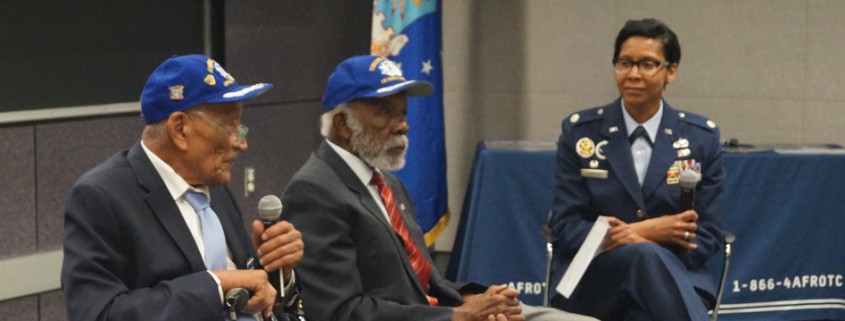Tuskegee Airmen discuss segregation in World War II
The 29 days of Black History Month flew by, but not before one piece of history was able to land on campus. Two Tuskegee Airmen recounted their stories of breaking the color barrier in the U.S. Armed Forces during World War II on Monday.
Jerry Hodges and Theodore Lumpkin Jr., who graduated from USC in 1950 and 1947, respectively, were part of the all-black unit in the U.S. military that served as aviators. At the time, the military was segregated, and African Americans were pushed to marginal roles in combat. When the Tuskegee Airmen started training in 1941, it was an experiment on the part of the U.S.
“We thought, what we were doing, we were improving the lots of blacks,” Lumpkin, who worked with military intelligence, said of their service.
The all-black unit received their name from the base where they trained — the Tuskegee Army Air Field in Tuskegee, Alabama. Tuskegee Airmen also included engineers, mechanics and intelligence officers.
The unit’s success is largely credited for paving the way to integration of the whole U.S. military in 1948. Today, the U.S. Air Force is 14 percent African American, according to the Air Force Personnel Center.
Hodges was in his early twenties when he started training with the unit. Now in his 90s and wearing a navy blue Tuskegee Airmen uniform, Hodges said his time in the service remains one of “most rewarding” things in his life.
“If you can really devote yourself to a goal, you can accomplish it,” Hodges said. “Many times there are going to be disappointments, but you can overcome it. Nothing is easy, and nothing is free. You’re going to have to work for it, but it’s worth it.”
Despite their prominence in black history today, the men both agreed that at the time they did not feel like they were writing themselves into the history books.
“History is being made everyday like it’s being made here,” Lumpkin said. “If you do your best each and every time that you can, that history becomes your legacy and hopefully when people look at it in time, it will be something that they will look up to and say, ‘That was a really important thing that happened.’”
The precise number of Tuskegee Airmen is still unknown. Lumpkin says most agree that the number is around 14,000. Many have passed away or are in their late 80s or early 90s.
“There will probably never be another all-black Air Force again because the military was completely segregated,” Lumpkin said. “We have a integrated military that is outstanding. It’s really typical of the Air Force
“We had sharecroppers, farmers and we had Ph.D.s, but we were all on the same level,” Hodges said. “Just the discipline that was enforced on us made us bond together. We still keep in touch.”
Hodges said he still receives an email from one of his comrades every day. Today, both Hodges and Lumpkin are part of the Tuskegee Airmen veteran’s group in Los Angeles.
The Center for Black Cultural and Student Affairs and the Air Force ROTC Detachment 060 brought the two veterans to campus as part of their Black History Month celebrations. About 20 students, faculty and guests to campus attended the panel.
Tayanna Todd, a sophomore majoring in film and television production and Spanish, said that when she found out that the legendary Tuskegee Airmen would be on campus she knew she had to attend. She has admired the unit’s service since she first heard about them in high school.
“We don’t have many opportunities to have living history right here in our face,” Todd said. “So just having that opportunity to hear them and listen to them and see them and continue to have that history right there presented to us is a once-in-a-lifetime opportunity.”
Though Hodges and Lumpkin said they did not realize their impact while they were serving as young men, they are grateful to be able to see the progress the country has made in terms of racial equality.
“It’s good to still be around, I’m pleased with that,” Lumpkin said.

